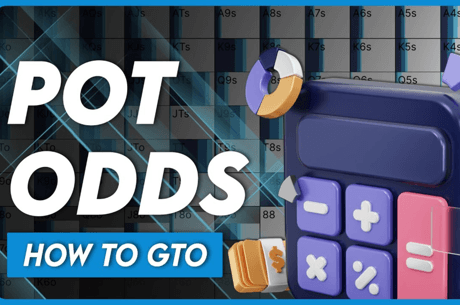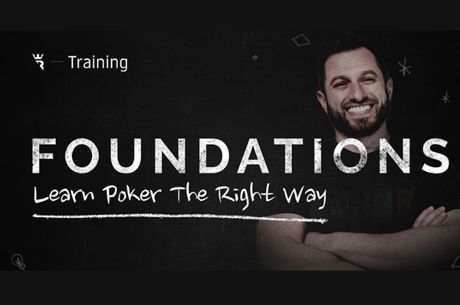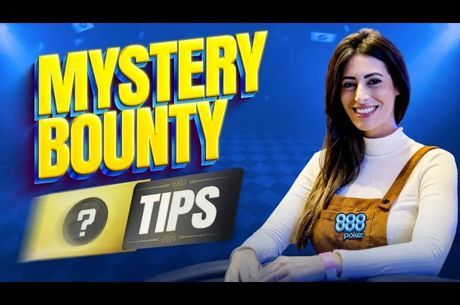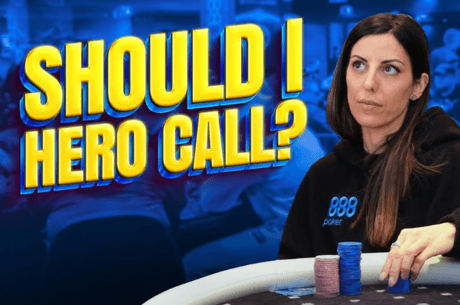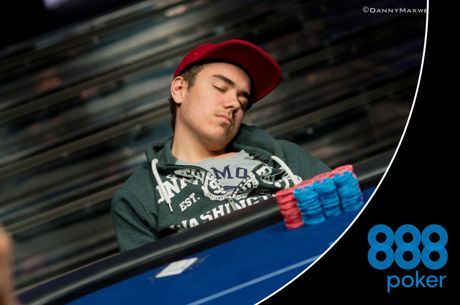Do I Call or Fold? How Bayes’ Theorem Can Help Navigate Poker’s Uncertainty, Part 2

In last week’s article, I introduced you to a mathematical tool called Bayes’ Theorem. It’s a way of combining two pieces of information in order to arrive at a best estimate of a probability of something. There we learned about the methodology of Bayes’ Theorem, noting how useful it can be when faced with certain decisions at the tables. It’s time (finally!) to get to some poker examples.
Let’s imagine you’re playing a heads-up cash game for all the money you have in the world. (Which is a bad idea. Don’t ever do that.) Your opponent is named Teddy, and he bears an uncanny resemblance to John Malkovich.
You’ve been playing for many hours, and because you are observant, you have been able to build a good mental database of how Teddy plays. When he bets on the river, about 60% of the time it’s a value bet; he’s bluffing about 40%.
So now you’re facing just such a river bet, and your hand is, say, top pair with a mediocre kicker. It’s functionally just a bluff-catcher. If you think Teddy is value betting, it’s surely with a better hand than yours, and you should fold. You’ll call only if you conclude that he’s bluffing.

Fortunately, you have picked up a tell on Teddy. He has a tray full of Oreo cookies next to him as he plays. When he’s waiting for you to make a decision, he’ll pick one up and twist it open. His tell is that when he’s strong, he’ll then eat the cookie, but when he’s bluffing, he puts it together again and back into the tray.
Unfortunately, this tell, like most others, is imperfect. Sometimes he’s bluffing but eats the cookie, anyway, and sometimes he’s value betting but puts the cookie away. Your careful tally shows that when he’s bluffing, he’ll put the cookie away 80% of the time, but eat it about 20% of the time. When he’s value betting, those numbers are reversed. Note that this is a very good tell — about 80% accurate, making it much more reliable than most.
On this particular hand, as you’re pondering your action, he puts the cookie back. Should you call or fold?
We construct a table, in the same way as shown in Part 1:
| Value betting | Bluffing | Totals | |
|---|---|---|---|
| Eats cookie | 48 | 8 | 56 |
| Puts cookie away | 12 | 32 | 44 |
| TOTALS | 60 | 40 | 100 |
The bottom row represents our knowledge of the prior probability, just based on his betting pattern in this kind of situation, before considering the tell. Each column divides that total into the 80% accurate and 20% inaccurate tell categories, as we’ve done before. Like last week, I’m assuming that we have 100 trials, so that I can use numerals instead of percentages. (It works the same either way, but it’s a little clearer like this.)
Now we can determine the important thing — what is the probability that he is bluffing, given the information from his betting pattern and from the tell?
Because he put the cookie away, we look at the second row, and find that he is bluffing 32 out of 44 times, or 73%. In other words, the tell, even though imperfect, raises our estimation of the probability that he is bluffing from a baseline of 40% to 73%. That, in turn, may well change our action from a fold to a call. Of course, that ultimate decision also depends on the size of the bet and the size of the pot — but I’m ignoring that for now, to avoid further complicating the math.
By now you should be able to sense that this outcome is largely dependent on the fact that his value-bet-to-bluff ratio is quite well balanced, leaving you with a difficult decision before you factor in the tell. But suppose Teddy weren’t this balanced — what then?
Let’s say, instead, that he’s something of a nut-peddler, such that his river bets are 90% strong hands and only 10% bluffs. And suppose that the cookie tell still has the same 80% reliability both ways. So before considering the tell, our baseline action is to fold, because his bet already means a 90% chance that he’s going for value with a hand we can’t beat.
But then he puts the cookie away — an action we have observed he does 80% of the time that he is bluffing and 20% of the time that he is strong. Call or fold?
Our new table looks like this:
| Value betting | Bluffing | Totals | |
|---|---|---|---|
| Eats cookie | 72 | 2 | 74 |
| Puts cookie away | 18 | 8 | 26 |
| TOTALS | 90 | 10 | 100 |
The information we need is in the second row of numbers. Given his 90/10 betting pattern, the “puts cookie away” tell translates to a bluffing frequency of 8 out of 26, or 31%, and a value betting frequency of 18 out of 26, or 69%.
In short, our conclusion remains the same — fold — even though we have an 80% reliable tell saying that he’s bluffing. The reason for this counterintuitive conclusion is the strength of the information about his baseline betting pattern. This situation is exactly analogous to the taxicab problem discussed in Part 1. Even with a fairly reliable witness, the relative frequencies of the blue and green cabs turned out to weigh more strongly than her testimony.
This is a semi-quantitative way of reinforcing the common wisdom about interpreting tells in poker, namely, that tells should be used as a kind of tie-breaker when you’re faced with a close, difficult decision. They are rarely definitive enough to override the much more important information you have based on knowledge of the player’s style and consideration of what makes sense in this specific situation.
In other words, when the latter kind of information (about a player’s style and tendencies) is strong, you should be inclined to disregard a contrary tell. But when you’re basically reduced to just guessing, a good tell is an excellent way to nudge the decision one way or the other.
In their book The Mathematics of Poker, authors Bill Chen and Jerrod Ankenman give this excellent example of using Bayes’ theorem in poker:
“A new player sits down in the game. Using all the observational information available to us, which might include stereotyping the player’s ethnicity, gender, manner, wardrobe, personal appearance, and so on, we conclude that he is 10% likely to be a ‘maniac’ who will raise 80% of his hands from the cutoff and 90% likely to be a tight player who will raise 10% of his hands from that seat. On the first hand he plays, he raises from the cutoff. (Assume there is no posting.) Now what is the probability that he is a maniac?”
Chen and Ankenman solve this using symbolic algebra. But I think that’s harder to understand, so here’s how this “story problem” (to use a term from the math books of my youth) gets reduced to a table:
| Maniac | Tight player | Totals | |
|---|---|---|---|
| Raises from cutoff | 8 | 9 | 17 |
| Doesn’t raise | 2 | 81 | 83 |
| TOTALS | 10 | 90 | 100 |
Our baseline estimate — technically the “prior probability” we discussed last week — is represented by the bottom row: 90% tight player, 10% maniac. The problem, as stated, defines for us what these terms mean, and that is reflected in the columns. The maniac will raise 80% of his hands from the cutoff position (here, 8 out of 10), while the tight player will raise 10% (here, 9 out of 90). The “raises from cutoff” in this example functions analogously to Teddy’s “cookie tell.”

The information we seek is in the first row. When he raises, contrary to expectations, it elevates our assessment of the likelihood that he is playing like a maniac. To be exact, our estimate changes (significantly) from a baseline of 10% to 8/17, or about 47%.
“So simply by observing this player raising the first hand, we can adjust the probability of this player being a maniac from just 10% to 47% immediately,” Chen and Ankenman continue. “If the player raises the first two hands… this probability moves to nearly 87%! Of course, these probabilities are subject to the accuracy of our original assumptions — in reality, there are not just two types of players, and our probability estimates are probably not so crisp about what type of player he is.”
Chen and Ankenman go on to show how Bayes’ theorem can be used to answer very different kinds of poker questions, such as whether the results of a player with an unusually high win rate are more likely due to exceptional skill or to a run of good luck. Such applications are much more difficult to explain, but use the same underlying kind of math. If I have succeeded in arousing your interest in how this mathematical concept can be used to answer more advanced poker questions, I recommend studying Chapter 3 of their book.
Nobody expects you to pull out pen and paper and construct 2 x 2 grids while you’re at the poker table. But as with other poker applications of math, with some practice you can learn to make decent approximations of the actual result mentally, and in just a few seconds, without resort to precise calculations.
I hope this introduction has given you the basics of what Bayes’ theorem is, and how it applies to making probabilistic poker inferences by combining two or more pieces of imperfect information — which, after all, is all we ever have while playing the game we love.
Robert Woolley lives in Asheville, NC. He spent several years in Las Vegas and chronicled his life in poker on the “” blog.
Want to stay atop all the latest in the poker world? If so, make sure to get PokerNews updates on your social media outlets. on Twitter and find us on both and !




